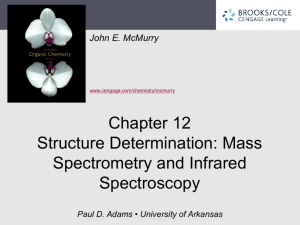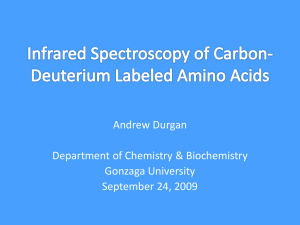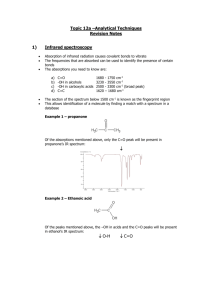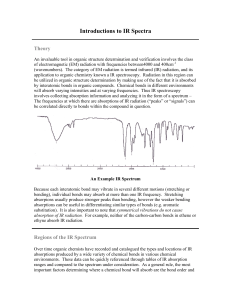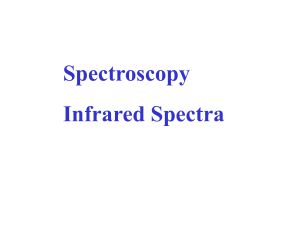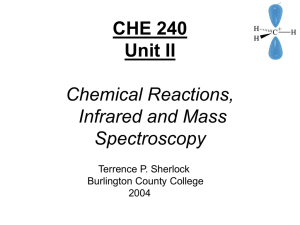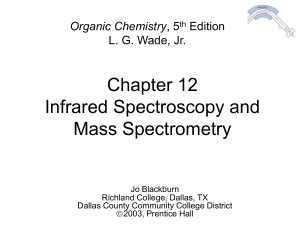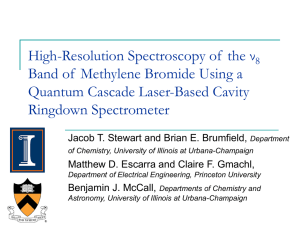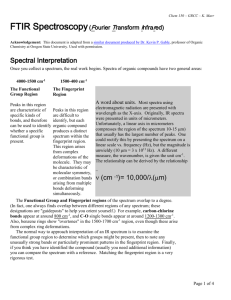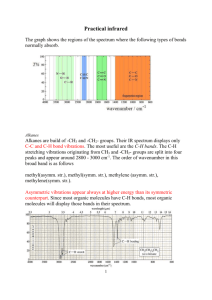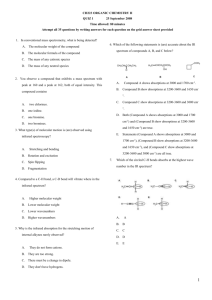Ch 12 Structure Determination (Mass Spec and IR) Part 2: Infrared
advertisement
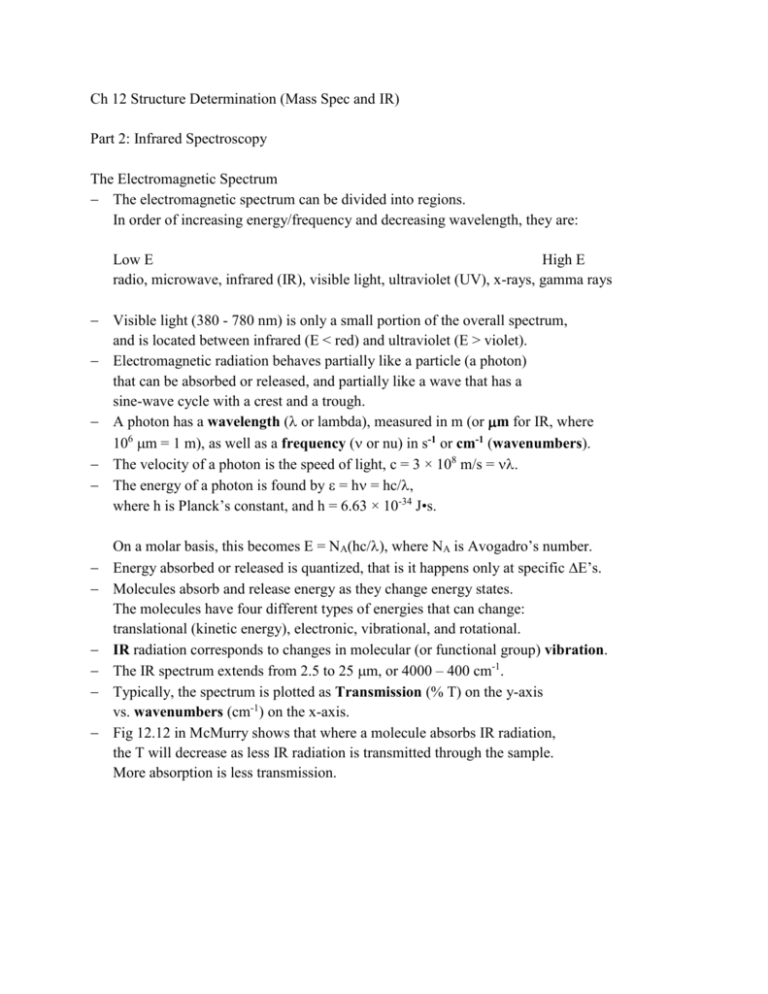
Ch 12 Structure Determination (Mass Spec and IR) Part 2: Infrared Spectroscopy The Electromagnetic Spectrum The electromagnetic spectrum can be divided into regions. In order of increasing energy/frequency and decreasing wavelength, they are: Low E High E radio, microwave, infrared (IR), visible light, ultraviolet (UV), x-rays, gamma rays Visible light (380 - 780 nm) is only a small portion of the overall spectrum, and is located between infrared (E < red) and ultraviolet (E > violet). Electromagnetic radiation behaves partially like a particle (a photon) that can be absorbed or released, and partially like a wave that has a sine-wave cycle with a crest and a trough. A photon has a wavelength ( or lambda, measured in m (or m for IR, where 106 m = 1 m), as well as a frequency ( or nu) in s-1 or cm-1 (wavenumbers). The velocity of a photon is the speed of light, c = 3 × 108 m/s = . The energy of a photon is found by = h = hc/, where h is Planck’s constant, and h = 6.63 × 10-34 J•s. On a molar basis, this becomes E = NA(hc/), where NA is Avogadro’s number. Energy absorbed or released is quantized, that is it happens only at specific E’s. Molecules absorb and release energy as they change energy states. The molecules have four different types of energies that can change: translational (kinetic energy), electronic, vibrational, and rotational. IR radiation corresponds to changes in molecular (or functional group) vibration. The IR spectrum extends from 2.5 to 25 m, or 4000 – 400 cm-1. Typically, the spectrum is plotted as Transmission (% T) on the y-axis vs. wavenumbers (cm-1) on the x-axis. Fig 12.12 in McMurry shows that where a molecule absorbs IR radiation, the T will decrease as less IR radiation is transmitted through the sample. More absorption is less transmission. Molecular Vibrations Chemical bonds are like springs, and they vibrate at characteristic frequencies. Vibrations are either stretches (along with accompanying compressions) or bends. Two bonds (with 3 atoms: X-Y-Z) can vibrate simultaneously (in phase). In this case, both stretching and bending can be either symmetric (like mirror images) or anti-symmetric (one bond compresses while the other expands). Bending can additionally be in-plane (flat/planar) or out-of-plane (not flat). For instance, in-plane symmetric bending is called scissoring, in-plane anti-symmetric bending is called wagging, out-of-plane symmetrical bending is called rocking, and out-of-plane anti-symmetrical bending is called twisting. IR Interpretation Functional groups have the same characteristic IR absorptions, practically regardless of the remainder of the molecule. The IR spectrum can be divided into four sections (see Fig12.15). 4000 to 2500 cm-1 (left side of spectrum) are due to bonds (of C, N, and O) to H atoms. 2500 to 2000 cm-1 are due to triple bonds (C≡C or C≡N). 2000 to 1500 cm-1 are due to double bonds (C=C, C=N, or C=O). Less than 1500 (right side of spectrum) is called the fingerprint region, where all molecules have different absorptions. These absorptions are often complex and difficult to diagnose. Characteristic IR Absorptions of Hydrocarbons Alkanes display the following absorptions: o C-H stretches at 2850-2960 (strong/medium) o C-H bend at 1500 (medium) o CH2 rock at 750 (weak) These vibrations tend to be apparent in the IR for most organic substances. The C-C vibration at 800 - 1300 (section 12.8) is weak and difficult to diagnose. Ignore this vibration completely. See also Figure 12.20a (12.14a in 8e) and Problem 12.32 in McMurry 9e. Alkenes display the following absorptions: o =C-H bond at 3020 -3100 (medium and sharp) o C=C at 1640 – 1680 (medium – weak). Mono-substituted alkenes (RCH=CH2) have two strong absorptions at 910 and 990. 2,2-disubstituted alkenes (R2C=CH2) have a strong absorption at 890. See also Figure 12.20b (12.14b in 8e) and Problem 12.32. Alkynes display their C≡C bond at 2100 – 2260 (medium). Terminal Alkynes (RC≡CH) show their ≡C-H bond at 3300 (strong). See also Figures 12.20c and 12.17 (12.14c and 12.28 in 8e), as well as Problem 12.41. Alkyl Halides have absorptions below 800 cm-1. However, these are not seen if the sample is analyzed with NaCl salt plates, which become opaque to IR below 800 cm-1. Alcohols (ROH) show their O-H bond at 3200 – 3500 (strong and very broad). One cautionary note here is that water displays this same vibration as well, and is a common contaminant in organic samples. One more cautionary note about water… Never ever put an aqueous sample on a salt plate! (What happens to NaCl in water?) Alcohols also show the C-O bond at 1050 – 1150 (strong). Both absorptions are visible in Figure 12.18 (12.12 in 8e). See also Worked Example 12.5a and Figure 17.11. Carbonyl (C=O) compounds have a very strong prominent absorption at 1670 – 1780. The exact position depends on the nature of the compound - that is whether the compound is an aldehyde, ketone, ester, carboxylic acid, etc. See Worked Examples 12.5b and 12.6, as well as Figure 19.14 and Table 19.2. Carboxylic Acids (RCOOH) have an OH attached to the carbonyl C. The acid’s O-H bond has a very strong and very broad absorption at 3100 – 2500. See Figure 20.5. IR Absorptions for Functional Groups Alkane or Alkyl Group (sp3) C-H C-H H-C-H 2 Alkene (sp C, same as vinylic) =C─H C=C RCH=CH2 R2C=CH2 Alkyne (sp C) C─H CC Alcohol O-H Alcohol or Ether C-O 2 Aromatic (sp ring w/ alternating dbl bonds) C-H Ring Ring Amine N-H C-N Carbonyl C=O Aldehyde O=C─H Carboxylic Acid (O─H) O=C-O─H Nitrile CN 3000 – 2850 1500 750 3100 - 3020 1680 – 1640 910 and 990 890 3300 2300 – 2100 3650 – 3200 1200 – 1050 3030 2000 – 1660 1600 – 1450 3500 – 3300 1230 – 1030 1800 – 1650 2850 – 2700 3300 – 2500 2260 – 2210 broad sharp small / sharp broad small bumps usually two sharp strong very broad
